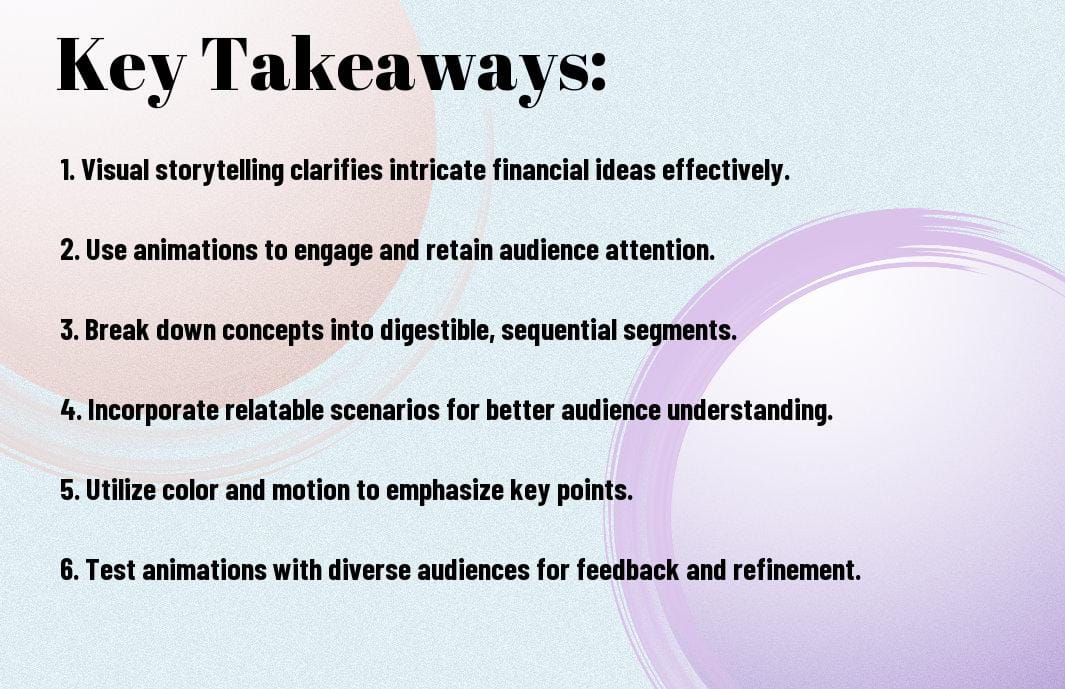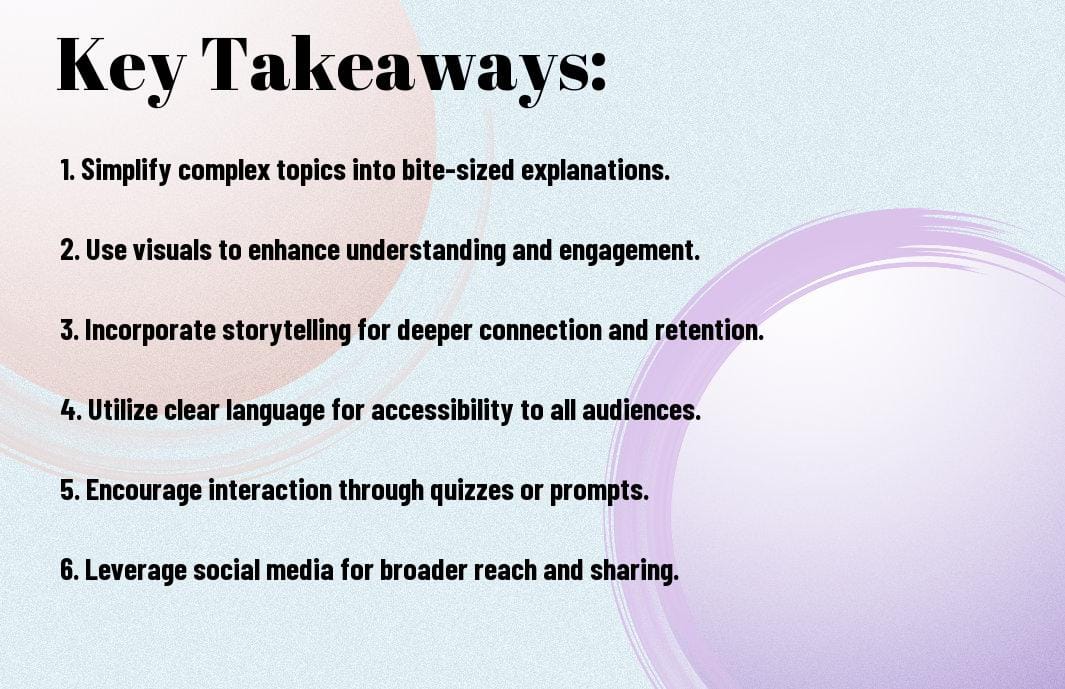
by Candido | Nov 1, 2024 | Financial Services
With the rapid evolution of financial services, you might find yourself struggling to grasp intricate concepts. Animation serves as a powerful tool to illustrate and clarify these ideas, making them accessible for your audience. By integrating engaging visuals with concise explanations, you can enhance understanding and retention. This blog post will guide you through effective techniques for leveraging animation in financial services presentations, empowering you to simplify complex topics and connect with your audience more profoundly.

Key Takeaways:
- Visual Clarity: Utilize animations to break down intricate financial concepts into simpler, easier-to-digest visuals that enhance understanding.
- Engagement Factor: Incorporate storytelling elements within animations to capture the audience’s attention and maintain interest throughout the explanation.
- Emphasis on Key Points: Use animations to highlight significant data and trends, ensuring that the audience focuses on imperative information without feeling overwhelmed.

Understanding Financial Services
Definition and Scope
Understanding financial services requires a clear grasp of their definition and broad scope. Financial services encompass a range of economic services offered by the finance industry, including banking, investments, insurance, and estate planning. These services are vital for individuals and businesses alike, providing tools for monetary management, risk assessment, and wealth creation. As you navigate through your financial journey, you’ll encounter various instruments and entities that play a significant role in shaping your financial outcomes.
The scope of financial services extends beyond mere transactions to include a comprehensive suite of services designed to enhance your financial literacy. This can include tools for budgeting, financial planning, investment advising, and more. By familiarizing yourself with these services, you empower yourself to make informed financial decisions that align with your life goals.
Importance of Visualization
Importance of visualization in financial services cannot be understated, especially when it comes to making complex concepts more digestible. As you examine into financial planning or investment strategies, you may find the associated data and information overwhelming. This is where visual aids such as graphs, charts, and animations come into play, enabling you to process information quickly and effectively. By translating intricate financial information into visual formats, these tools aid in clarifying patterns, trends, and potential outcomes.
Hence, utilizing advanced visual techniques can significantly heighten your understanding of financial statistics and market dynamics. When you visually engage with your financial data, you can more quickly identify opportunities and risks. Whether you’re assessing investment portfolios or crafting a budget, visualization not only simplifies complex information but also enables you to make more informed decisions, ultimately leading to improved financial health and fulfilling your financial objectives.
The Role of Animation in Financial Education
Some individuals find financial concepts daunting and challenging to grasp. By utilizing animation, you can transform complex information into engaging visuals that facilitate better understanding. Animation serves as a bridge between complicated financial principles and the viewer’s comprehension, making learning more interactive and enjoyable. It allows you to visualize processes, understand relationships, and connect dots in ways static images or text may not achieve.
Benefits of Using Animation
The use of animation in financial education offers several noteworthy advantages. First, it increases engagement, as dynamic visuals naturally catch your eye and keep your attention longer than traditional formats. Furthermore, animations simplify the delivery of intricate information without oversimplifying the content. This means that you can absorb complicated concepts such as investment strategies and financial forecasts with more ease and clarity.
Types of Financial Animations
Behind the versatility of financial animation lies an array of types that cater to various educational needs. Each type can efficiently illustrate different aspects of finance, providing you with tailored solutions for specific challenges. Here’s a look at some of the prominent types of financial animations:
| Type of Animation |
Description |
| Explainer Videos |
Short videos that break down specific concepts. |
| Infographics |
Visuals that combine data and graphics to tell a story. |
| Animated Charts |
Dynamic representations of data that change over time. |
| Character-led Stories |
Narratives that use characters to explain financial concepts. |
| Interactive Simulations |
Engaging experiences that allow you to explore scenarios. |
By understanding the different types of financial animations, you can choose the best format that fits your learning style and educational goals. Each type has its own unique way of communicating information, which can help you retain and apply knowledge effectively.
- Explainer Videos for quick learning
- Infographics for visual learners
- Animated Charts for data analysis
- Character-led Stories for relatable scenarios
- Interactive Simulations to practice in real-time
Benefits of incorporating animation into your financial education strategy are countless and impactful. By capitalizing on the unique advantages of animation, you can enhance your understanding and retention of complex subjects. Below is a summary of some key benefits:
| Benefit |
Impact |
| Enhances Engagement |
Captures viewers’ attention effectively. |
| Simplifies Complexity |
Makes challenging concepts easier to digest. |
| Aids Memory Retention |
Improves recall through visual storytelling. |
| Encourages Exploration |
Fosters curiosity about financial topics. |
| Provides User Interaction |
Engages through participatory learning. |
Utilizing animation within your financial education can yield profound benefits in your learning journey, helping you navigate the complexities of finance with greater ease and confidence. The power of animation can truly revolutionize how you approach financial literacy.
Key Concepts Simplified by Animation
Not only can animation clarify complex financial concepts, but it can also engage viewers in ways traditional formats cannot. When you utilize animation, your audience can grasp themes like financial markets more readily, as these visual narratives can transform abstract ideas into tangible understanding. By presenting dynamic graphs, timelines, and illustrations, you allow viewers to visualize relationships within the financial ecosystem, making it easier for them to comprehend how various market factors influence one another.
Financial Markets
Against the backdrop of ever-evolving economic landscapes, animated explanations can distill a wealth of information regarding financial markets into digestible snippets. You can illustrate how markets operate, shedding light on key roles such as buyers and sellers. Furthermore, you can highlight the interplay between different types of markets—like stocks, bonds, and commodities—helping your audience understand the complexities behind trading mechanisms and market behavior. This engagement fosters not only understanding but also a sense of confidence in your audience’s ability to navigate financial systems.
Investment Strategies
Markets present unpredictable outcomes, yet using animation to depict various investment strategies can help simplify your approach to understanding these risks. When you animate different strategies, such as dollar-cost averaging or diversification, you can effectively illustrate how each serves to mitigate risk while aiming for optimum returns. You allow your audience to visually compare potential outcomes, showcasing the benefits and drawbacks of each strategy within a cohesive framework.
The animated representation of investment strategies transforms dry numbers and theories into entertaining and informative visuals. It can help you pinpoint strategic adjustments based on market conditions, making it easier for you to identify risk management techniques that align with your investment goals. By employing visuals, you enhance engagement and retention of information, allowing you to navigate the intricacies of investing with confidence and clarity.
Designing Effective Financial Animations
For effective financial animations, it’s imperative to follow best practices that resonate with your target audience. Engaging storytelling is fundamental; merging concepts into a narrative helps the viewer build connections and makes the information more relatable. Begin by identifying the key messages you want to convey, and ensure they are presented clearly and simply. Using relatable characters and situations can also enhance engagement, making the financial information feel more approachable and less intimidating.
Best Practices in Animation Design
At the core of effective animation design is the balance between aesthetics and functionality. You should avoid cluttering your animations with excessive information or visuals; instead, focus on one central theme at a time. Keep your visuals simple, using a consistent color palette and typography that aligns with your brand identity. Additionally, pacing is vital. Ensure that your animations progress at a speed that allows viewers to absorb the information without feeling rushed, as this aids comprehension and retention.
Tools and Software to Consider
For creating impactful financial animations, using the right tools and software can greatly enhance the production process. Various platforms like Adobe After Effects and Blender offer advanced features for 2D and 3D animations while being versatile enough to cater to different project needs. If you’re seeking more accessible options, tools such as Animaker and Vyond allow you to create animations through user-friendly interfaces with predefined templates. Additionally, incorporating sound effects and voiceovers can significantly improve the overall quality and engagement level of your animations.
In fact, choosing software that aligns with your skill level is important, as some programs can have a steep learning curve while others are designed for quick and easy access. Assess your unique needs, budget, and resources before making a choice; this way, you can ensure *optimal production efficiency* and *effective outcome*. Engaging with community forums and tutorials can also help you utilize these tools to their fullest potential, making your financial animations not just informative but also visually captivating.

Case Studies: Success Stories
Many organizations have recognized the power of financial services animation in simplifying complex concepts. By employing animation as a tool for communication, these companies have successfully conveyed intricate financial data and strategies to their clients and stakeholders. Here are some notable case studies demonstrating the effectiveness of financial animations:
- Company A: Utilized animated explainer videos, resulting in a 60% increase in customer engagement and a 30% boost in new client acquisitions within six months.
- Company B: Developed an animated infographic for a financial product launch, which led to a 40% increase in conversion rates compared to previous launches without animation.
- Company C: Created a series of animation videos that simplified their annual financial reports. This approach improved audience retention by 50% during presentations.
- Company D: Used animation in employee training programs, enhancing understanding of complex regulations and leading to a 70% reduction in compliance errors.
For more insights into how financial animation can transform your communication strategies, check out Finance Animation Explained | Keystone Media.
Companies Leveraging Animation
After analyzing various successful cases, it’s clear that numerous financial companies have leveraged the power of animation to improve how they deliver information. Whether it’s simplifying intricate financial products or enhancing internal training processes, organizations are tapping into the engaging aspects of animation to convey their messages clearer and more concisely. This approach not only captivates the audience’s attention but also facilitates better understanding, leading to informed decision-making.
Measurable Outcomes
Stories of success with financial services animation reveal significant improvements across various metrics. By integrating animated content, companies have experienced remarkable shifts in their operational performance. These measurable outcomes not only showcase the effectiveness of animation but also provide clear indicators that reinforce the investment in this creative medium.
Animation plays a pivotal role in achieving effective communication. Through these success stories, it becomes evident that utilizing animation leads to greater audience engagement, improved retention rates, and significant conversion rate increases. The numbers speak volumes: companies that invest in animation see a demonstrable return on their investment, proving that this technique is not just a trend but a valuable asset in the world of finance.
Challenges and Considerations
All animations have their unique set of challenges, especially when it comes to conveying financial concepts effectively. One of the primary pitfalls is the risk of oversimplifying the information. While it’s tempting to make financial topics digestible through animation, you must be careful not to strip away vital details that provide depth and context. This can lead to misunderstandings or misinterpretations of the information you want to communicate. Additionally, animations that are too flashy or distracting may divert attention away from the key points, making it harder for viewers to grasp important concepts.
Common Pitfalls
After stepping into animations, you might also encounter the challenge of audience engagement. It’s important to create animations that resonate with your target demographic; otherwise, your efforts may fall flat. If the animation doesn’t align with the interests or knowledge level of your audience, it will likely fail to serve its purpose. Take care in crafting narratives and visuals that will engage viewers emotionally while supporting their quest for financial understanding.
Ensuring Accessibility and Understanding
About ensuring accessibility, it’s vital that your animation caters to a diverse audience. This includes considering those with various learning styles and abilities. Integrating elements such as subtitles or voiceovers can significantly enhance comprehension for individuals with hearing impairments or those who prefer auditory learning. Additionally, using clear language and avoiding financial jargon can help you reach a broader audience, allowing more people to benefit from your animations.
To create effective financial services animations, you’ll need to prioritize accessibility and understanding throughout the entire process. By including clear and concise visual elements alongside verbal explanations, you can help reinforce the message you’re trying to convey. Make it a point to evaluate the final product through the lens of your intended audience; gather feedback, and be willing to make adjustments to enhance clarity. Your objective should be to ensure that everyone, regardless of their background, can engage with and understand your financial concepts without unnecessary barriers.

Final Words
So, as you navigate through the intricate landscape of financial concepts, utilizing financial services animation can serve as a powerful tool in your arsenal. By simplifying complex ideas into engaging visuals, you can enhance your understanding and retention of vital financial information. This approach not only makes learning more enjoyable but also ensures that you can communicate these concepts effectively to your audience. Whether you are explaining investment strategies, budgeting, or the intricacies of loans, animation provides a clarity that traditional methods often lack.
Additionally, incorporating animated content into your financial education strategy allows you to cater to various learning styles. By appealing to visual learners, you can hold their attention and convey your message more effectively. If you want to explore the benefits of this approach further, check out Why Finance Animation is Essential for Your Business. By embracing financial services animation, you empower yourself to tackle complex financial topics with ease and confidence, ultimately leading to informed decision-making in your personal and professional life.
FAQ
Q: What is financial services animation?
A: Financial services animation refers to the use of animated visual content to convey complex financial concepts in an engaging and easily digestible format. This approach utilizes visuals, motion graphics, and storytelling techniques to break down intricate ideas into simpler, more intuitive representations, making it easier for audiences to understand and retain financial information.
Q: How can animation simplify complex financial concepts?
A: Animation can simplify complex financial concepts by utilizing visuals to illustrate abstract ideas. By incorporating colorful graphics, characters, and scenarios, viewers can more easily identify with the content. Animation can also employ metaphors and analogies to relate financial principles to everyday experiences, making the concepts more relatable and easier to grasp.
Q: What types of financial concepts can be effectively illustrated using animation?
A: Various financial concepts can be effectively illustrated using animation, including investment strategies, budgeting techniques, loan processes, retirement planning, and the workings of financial markets. Animations can demonstrate how these concepts operate through step-by-step visuals, helping audiences visualize the processes and understand their implications.
Q: Who can benefit from financial services animations?
A: Numerous audiences can benefit from financial services animations, including individuals seeking personal finance knowledge, students learning about economics, and professionals in the finance sector aiming to simplify their presentations. Additionally, organizations providing financial services can use these animations to educate clients about products and services, improving client engagement and comprehension.
Q: What are some effective ways to distribute financial services animations?
A: Financial services animations can be effectively distributed through various channels, including social media platforms (like YouTube, Facebook, and LinkedIn), websites, and email newsletters. Incorporating animations into webinars and virtual workshops can also enhance the presentation of financial information. Optimizing the animations for mobile viewing ensures accessibility for users on different devices.

by Candido | Oct 31, 2024 | Video Production
You can effectively convey your fintech startup’s message through animated explainer videos, which are engaging and informative. By utilizing captivating visuals and clear messaging, you can showcase your innovative solutions and attract potential clients. In this guide, we’ll walk you through the steps to create professional-looking animations that highlight your unique value propositions. You’ll also learn how to connect with your audience on a personal level, ensuring that your startup stands out in a competitive market.
Key Takeaways:
- Understand Your Audience: Tailor your animated explainer videos to resonate with your target demographic, addressing their specific pain points and financial needs.
- Keep It Engaging: Use a compelling narrative and captivating visuals to maintain viewer interest and effectively communicate your fintech solutions.
- Highlight Unique Features: Showcase what sets your fintech startup apart by clearly presenting the unique benefits and functionalities of your offerings.

Understanding Your Audience
For your animated explainer videos to resonate with viewers, it’s important to have a deep understanding of your audience. This involves knowing who they are, what they seek, and how your fintech startup can address their specific needs. By comprehending the demographics of your target market, you can create content that speaks directly to their interests and behaviors, ensuring your message is effective and engaging. Incorporating this understanding into your video can strengthen the connection between your brand and potential customers, enhancing their likelihood of conversion.
Identifying Target Demographics
On the path to effective communication, identifying your target demographics is a vital first step. You should examine factors such as age, gender, income level, education, and location. This data will help you paint a detailed picture of who your ideal customers are. Consider leveraging analytics tools and surveys to gather insights into your audience’s preferences and behaviors. Once you have this information, you can tailor your video content to better appeal to these specific groups, utilizing language, visuals, and scenarios that reflect their unique experiences and expectations.
Analyzing User Pain Points
One of the most effective ways to connect with your audience is by analyzing their pain points. You need to investigate the challenges and frustrations your potential customers face within the fintech landscape. This might involve exploring issues such as financial literacy, security concerns, or the complexity of existing solutions. By pinpointing these pain points, you can position your product or service as the answer they’ve been searching for, allowing you to create compelling narratives in your videos that illustrate how your solution directly addresses their issues.
Also, when you examine into understanding user pain points, it’s crucial to highlight how your fintech solution offers simplicity in navigating financial challenges. Your goal should be to showcase not just the features of your service, but also the transformative impact it has on users’ lives, emphasizing aspects such as enhanced security, better accessibility, and personalized experience. By addressing these factors effectively in your animated explainer videos, you enhance user engagement and build trust in your brand, making it more likely that your audience will convert into loyal customers.
Crafting the Storyline
Now that you understand the significance of animated explainer videos for your fintech startup, it’s time to focus on crafting an engaging storyline. An effective explainer video should have a clear, compelling narrative that resonates with your audience. This begins with defining what makes your fintech solution unique, articulate how it solves a real problem, and the benefits it offers. You can explore more on this topic through Explainer Video for Fintech resources to gather inspiration and guidance.
Establishing Clear Objectives
Across the narrative development process, establishing clear objectives is imperative for creating a focused explainer video. Consider what you aim to achieve with your video. Are you looking to raise awareness, drive conversions, or educate potential customers about your product? Identifying your primary goal will steer your narrative in a way that effectively highlights your fintech solution and ensures your message is succinct and impactful.
Structuring the Narrative Arc
Beside establishing objectives, structuring the narrative arc is vital for maintaining viewer engagement. Your story should follow a predictable trajectory that includes an introduction, rising action, climax, falling action, and resolution. Start with a hook to capture attention, then gradually build tension by introducing challenges your target audience faces. Follow this with the climax where you present your fintech solution as the hero, and finally, conclude with a powerful resolution that reinforces the positive outcomes of using your service.
For instance, you might begin with a relatable scenario highlighting a common pain point, then introduce your fintech product that offers a streamlined solution. The key is to keep the narrative flow logical and engaging—allow the audience to follow along easily while making emotional connections. This structured approach not only enhances engagement but also helps to *effectively communicate your message*, driving home the significance of your solution in a manner that encourages viewers to take action.

Designing the Visuals
Once again, as you begin on creating your animated explainer video, the visuals will play a pivotal role in conveying your fintech startup’s message. This is where the right blend of creativity and clarity comes into play. You want your visual elements to not only catch the viewer’s attention but also to communicate your core value proposition effectively. A well-designed explainer video can significantly enhance viewer retention, making it important to select a style that resonates with your target audience. For inspiration, check out these Top Fintech Animated Explainer Videos that set the benchmark in achieving this balance.
Choosing the Right Animation Style
Below, you need to evaluate various animation styles available to ensure you select one that aligns with your brand’s identity and message. Whether it’s 2D animation, motion graphics, or even whiteboard animation, each style conveys a different tone and level of engagement. A more playful approach might appeal to a younger target audience, while a sleek, minimalist style could resonate better with professionals in the investment sector. Therefore, ensure that the choice of animation style not only captivates but also clarifies your unique selling points.
Incorporating Brand Elements
Around your chosen animation style, it is important to incorporate your brand elements to create a cohesive visual identity throughout the video. This involves using your brand color palette, typography, and logo strategically to enhance recognition. Doing so not only reinforces your brand image but also helps viewers associate the animated video with your fintech startup easily. By integrating these elements, you create a sense of familiarity and trust, which can significantly impact viewer perceptions.
Also, it’s beneficial to ensure that your brand elements are not just present but are also harmoniously blended into the visual design. Using your brand colors effectively can evoke the right emotions, while a consistent typography and placements of the logo can help in maintaining a professional look. Keep in mind, a well-integrated branding effort can turn your animated explainer from just another video into a standout piece that strengthens customer loyalty and recognition. Stay focused on making these elements a natural part of your storytelling process for the best results.

Developing the Script
To create an effective animated explainer video for your fintech startup, the first step is developing the script. The script will serve as the backbone of your video, guiding its content and ensuring clarity in your messaging. A well-crafted script addresses your target audience directly, articulating the pain points they experience and presenting your solution in a compelling and relatable way. It’s imperative to engage your viewers from the very first sentence, as this sets the tone for their viewing experience. You should aim to tell a story that not only informs but also captivates, fostering an emotional connection with your audience.
Writing for Clarity and Engagement
Behind every successful animated explainer video is a script that prioritizes clarity and engagement. Begin by outlining the key points you want to convey. Each concept should be broken down into simple, digestible segments that maintain your audience’s interest. Using dynamic language and maintaining a conversational tone can enhance the viewer’s connection with your message. Make sure to incorporate questions that provoke thought and resonate with the audience’s experiences, compelling them to explore your offerings further.
Balancing Technical Language with Simplicity
One of the challenges in creating content for a fintech audience is balancing technical language. Your startup likely operates in a complex ecosystem with jargon that may confuse your audience rather than enlighten them. The key is to distill these intricate ideas into simpler terms that maintain their essence while being easily understood. Focus on using everyday language to describe your concepts without diluting the information. You should aim for clarity by substituting complicated terms with relatable analogies or examples that your audience can visualize.
Engagement is the primary goal when addressing your audience. You want them to not only understand your message but also feel excited by the solutions your fintech startup offers. This means avoiding excessive technical details that could alienate potential customers. Instead, strive to present your ideas in an accessible way that speaks to your audience’s needs and aspirations. You can achieve this by explaining complex concepts through familiar situations, ensuring that your messaging remains inclusive and inviting while still showcasing your expertise.
Choosing the Right Tools and Technology
All fintech startups seeking to create compelling animated explainer videos must start with a clear understanding of the right tools and technology at their disposal. The choice of software not only impacts the quality of the final product but also influences your workflow and project timelines. It’s worth exploring various platforms that cater specifically to animation needs, as they can significantly boost the creativity and engagement of your video. To learn more about how animated explainer videos can enhance your fintech presentation, check out How Animated Explainer Videos for Fintech Help Improve ….
Software Options for Animation
Beside selecting the right animation style, choosing the appropriate software is fundamental to bringing your vision to life. Popular options include Adobe After Effects for more complex animations, or simpler platforms like Powtoon and Vyond that allow you to create animations quickly with user-friendly templates. Each software comes with its unique features and capabilities, so consider both your skill level and the specific elements you want to showcase in your video, such as character animations, infographics, or dynamic transitions.
Collaborating with Professionals vs. DIY
Choosing to collaborate with professionals or tackle the project yourself is another important decision in your video development journey. Engaging professional animators can provide you with a polished, high-quality product that aligns with your brand’s identity, leveraging their expertise to communicate complex fintech concepts effectively. On the other hand, if you possess a creative flair and want to save on costs, a DIY approach might suit your startup, allowing for personalized input and faster adjustments. However, keep in mind that without the necessary skills, time investment can be significant, and the quality may not meet industry standards.
Also, while DIY can be a rewarding experience, it comes with potential drawbacks, particularly if you lack experience in animation. The risk of producing a video that fails to convey your message clearly can have negative repercussions on your startup’s image. It’s important to weigh the benefits of a polished, professional outcome against the learning curve and time commitment required for a do-it-yourself project. Ultimately, the decision should align with your budget, timeline, and the level of quality you wish to achieve for your fintech explainer video.
Distribution and Promotion Strategies
Keep in mind that creating an animated explainer video is just the first step; effectively sharing it is key to maximizing its impact. Your video should be distributed across various platforms to ensure it reaches the right audience. Numerous options exist for sharing your video, including social media sites like Facebook, Instagram, LinkedIn, and YouTube. Each platform has its unique audience and engagement style, so tailor your video’s presentation and accompanying text accordingly. For instance, while Instagram is known for its visuals and short attention spans, LinkedIn’s users may appreciate a more professional tone that highlights the fintech solutions your startup offers.
Platforms for Sharing Your Video
Among the countless platforms available for elevating your fintech explainer video, choosing the ones that resonate most with your target market is important. Social media platforms can facilitate organic sharing and engagement, while embedding your video on your company’s website fosters a seamless user experience. Don’t underestimate the power of email marketing, as including your video in newsletters or email campaigns can significantly boost your visibility. Additionally, consider video-specific platforms like Vimeo or industry-focused forums where fintech discussions take place, ensuring that your content lands in front of those actively seeking solutions in the sector.
Optimizing for SEO and Engagement
About ensuring that your video not only captivates viewers but is also easily discoverable through search engines. Integrating relevant keywords in your video title, description, and tags can increase its visibility on platforms like YouTube, driving more traffic to your website. Your video’s thumbnail should be eye-catching and informative, as it plays a significant role in attracting clicks. Engaging viewers through interaction by including a clear call-to-action at the end of your video can further enhance its effectiveness, guiding users toward your desired outcome.
And to truly optimize your video for both SEO and engagement, consider analyzing viewer feedback and adapting your content based on what resonates best. Utilizing analytics tools will allow you to track the performance of your video, revealing insights such as watch time, audience demographics, and engagement rates. Leveraging this data will empower you to refine your video marketing approach continually, enhancing your future content and ensuring your fintech startup stands out in the crowded digital landscape.
Conclusion
Presently, creating an animated explainer video for your fintech startup involves a strategic approach that enables you to effectively communicate your unique offerings. By conducting thorough research, understanding your target audience, and crafting a compelling script, you lay the groundwork for a video that resonates with viewers. Utilizing animation allows you to simplify intricate concepts and engage potential customers, turning complex financial services into easily digestible content. By focusing on the visual narrative and maintaining a consistent brand identity, you ensure that your explainer video not only informs but also captivates your audience.
As you launch on this creative journey, keep in mind the importance of high-quality production and professional voiceovers, which contribute significantly to the overall effectiveness of your video. Don’t hesitate to collaborate with experts who specialize in animation and storytelling to elevate your project. Ultimately, an engaging animated explainer video can be a powerful tool in showcasing your fintech startup, attracting potential clients, and solidifying your position in a competitive market. By following these guidelines, you position yourself for success and establish a strong connection with your audience.
FAQ
Q: What are animated explainer videos and why are they important for fintech startups?
A: Animated explainer videos are short multimedia presentations that succinctly describe a concept, product, or service, often using animation to engage viewers visually. For fintech startups, these videos are vital because they simplify complex financial concepts, making them accessible to a broader audience. They also enhance brand awareness and can effectively highlight the unique benefits of a startup’s offerings, making it easier to connect with potential customers and investors.
Q: What steps should I take to create an effective animated explainer video for my fintech startup?
A: To create an impactful animated explainer video, follow these steps:
1. Define your message: Clearly outline what you want to communicate, focusing on the problem your fintech service solves.
2. Know your audience: Understand who your target demographic is to tailor the content and visuals accordingly.
3. Write a compelling script: Craft a script that is engaging and straightforward, usually lasting between 60 to 90 seconds.
4. Produce quality visuals: Work with professional animators or use animation software to bring your ideas to life with eye-catching graphics.
5. Include a call-to-action: Conclude the video with a strong call-to-action to encourage viewers to visit your website, sign up, or contact you.
Q: How long should an animated explainer video for a fintech startup be?
A: Ideally, an animated explainer video should be between 60 to 90 seconds long. This duration is generally enough to communicate your key messages without losing the viewer’s attention. It’s vital to maintain a balance between providing sufficient information and keeping the content brief and engaging.
Q: What elements make an animated explainer video more engaging for viewers?
A: To enhance viewer engagement in your animated explainer video, consider incorporating the following elements:
1. A captivating story: Narratives that resonate with the audience can significantly increase interest and retention.
2. High-quality visuals: Use bright, appealing animations that align with your brand’s aesthetics.
3. Friendly voice-over: A professional voice-over can bring warmth and relatability to the video.
4. Sound effects and background music: Appropriate audio elements can enhance the emotional connection and overall impact.
5. Clear and concise messaging: Simple language and straightforward explanations help keep viewers engaged and informed.
Q: How can I measure the effectiveness of my animated explainer video?
A: There are several metrics you can track to evaluate the effectiveness of your animated explainer video:
1. Views and Engagement: Monitor how many times the video has been viewed and the overall engagement rate (likes, shares, comments).
2. Click-Through Rate (CTR): If the video includes a call-to-action linking to your website, track how many viewers follow through.
3. Conversion Rate: Measure how many viewers take a specific action, like signing up for a service or requesting more information after watching the video.
4. Audience Retention: Analyze how long viewers are watching the video. High drop-off rates might indicate that your content needs to be more engaging.
5. Feedback: Collect direct feedback through surveys or comments to understand how well the video resonated with its audience and what could be improved.

by Candido | Oct 30, 2024 | Finance
Animated videos offer a dynamic way to simplify complex financial concepts, making them more accessible for you and your audience. With engaging visuals and concise storytelling, you can turn intimidating subjects into relatable knowledge that empowers your viewers. By utilizing animations, you not only enhance understanding but also maintain interest, ensuring your message resonates. To get started on this journey, explore resources on How to Create a Finance Animation Explainer Video and see how you can effectively communicate through animation.

Key Takeaways:
- Engagement: Animated videos capture attention, making complex financial concepts more appealing and memorable for viewers.
- Simplicity: Breaking down concepts into bite-sized segments helps viewers grasp information without feeling overwhelmed.
- Visual Representation: Utilizing visuals aids in illustrating abstract financial ideas, enhancing understanding and retention of the material.

Understanding Financial Concepts
While navigating the world of finance can often feel overwhelming, breaking down key concepts into digestible, animated videos can significantly enhance your understanding. These visual aids allow you to grasp complex ideas more easily by transforming abstract financial terminology into engaging narratives and relatable scenarios. By viewing animated content, you can connect the dots between theory and real-world applications, empowering you to make informed decisions about your finances.
Importance of Financial Literacy
Along your journey to becoming financially savvy, financial literacy plays a fundamental role in shaping your decision-making skills. It equips you with the knowledge to understand imperative concepts like budgeting, investing, and credit management, which can ultimately lead to better financial outcomes. When you are financially literate, you can avoid common pitfalls and make choices that enhance your financial well-being for the long term.
Common Financial Terms Explained
Below are some imperative financial terms that often baffle many aspiring financial enthusiasts. By familiarizing yourself with definitions and practical examples of terms like interest rates, assets, and liabilities, you can start to build a strong foundation that will support your financial journey. Animated videos can transform these often intimidating terms into visual stories, helping you see how they can impact your everyday life and long-term financial goals.
Importance lies in demystifying financial jargon so that you can engage confidently with your finances. It is imperative to not only learn what these terms mean but also to recognize their implications on your financial health. By understanding how investment works or what it means to take on debt, you can better navigate your choices and pave the way for achieving your personal financial goals. Armed with this knowledge, you are less likely to fall prey to misinformation and can take charge of your financial future.
The Power of Visual Learning
Some of the most effective ways to grasp complex financial ideas is through visual learning. By leveraging animated videos, you can present key concepts in a way that is not only engaging but also easier for your audience to understand. You can explore some of the most effective visual aids by checking out the Top 10 Animated Finance Explainer Videos. These videos can transform dry financial data into vibrant narratives, capturing attention and promoting better comprehension.
Cognitive Benefits of Animation
One of the standout advantages of using animation in financial education is its ability to simplify and condense information. Animated visuals can break down complex ideas into bite-sized, digestible pieces, making it easier for you to grasp the content. This mechanism can significantly facilitate your ability to connect different concepts together. When the intricate relationships between financial principles are illustrated through animations, you’re more likely to engage with the material on a deeper level.
How Animation Enhances Retention
Beside simplifying concepts, animation provides a dynamic and interactive learning experience that promotes higher retention rates. When you consume information through animation, you are more likely to engage both your auditory and visual senses, reinforcing the material in your memory. The combination of compelling visuals and sound can create a multisensory experience, making it easier for you to recall information when you need it.
A study found that learners who engaged with animated content retained up to 50% more information over traditional methods. This retention advantage is particularly significant in finance, where understanding fundamentals is necessary for making informed decisions. The visual storytelling approach taken by animated videos keeps your attention focused and enhances your ability to recall critical financial concepts long after you’ve consumed the content.
Creating Engaging Animated Videos
To effectively convey complex financial concepts, your animated videos must be both informative and captivating. This involves not only simplifying the information but also presenting it in a visually appealing way that keeps your audience’s attention. By utilizing color theory, motion design, and storytelling techniques, you can create videos that not only educate but also entertain. Incorporate characters and narratives that reflect real-life financial scenarios, making the content relatable and easier for viewers to grasp.
Key Elements of Effective Animation
Engaging animations rely on various key components that enhance viewer understanding and retention. First, consider the pacing of your video; the flow of information should be steady, allowing viewers to absorb what they learn without feeling rushed. Secondly, the use of visuals, such as graphs and charts, should not only reinforce your message but also be simplistic enough to avoid overwhelming the audience. Furthermore, appropriate voiceovers and sound effects can significantly enhance the overall experience, making your financial concepts more memorable.
Tools and Software for Animation
Across the spectrum of animation tools available today, you have a plethora of options to create your financial videos. From simple online platforms like Animaker and Powtoon to more professional software such as Adobe After Effects and Blender, each tool offers unique features that cater to different skill levels and requirements. The choice of software will ultimately depend on your specific needs and your familiarity with animation techniques.
Considering your desired outcomes, it’s important to select tools that align with your skill set and the complexity of the content you aim to produce. For instance, if you’re new to animation and need an accessible starting point, online tools offer user-friendly interfaces and templates to help you get started without a steep learning curve. On the other hand, for those comfortable with advanced techniques, software like Adobe After Effects provides in-depth capabilities for creating highly customized and professional-grade animations. The right choice can significantly enhance your ability to effectively communicate your financial concepts, ensuring your audience engages with your content.
Steps to Break Down Complex Topics
Your first step in breaking down complex financial topics is identifying the core concepts that form the foundation of the subject. This means stripping away extraneous details and focusing on the key ideas that you want your audience to understand. Between complicated terminologies and jargon, it’s easy to lose sight of what truly matters. By pinpointing these vital components, you can set the stage for creating clear and engaging animated videos that simplify the subject matter effectively.
Identify Core Concepts
Between different financial topics, there are certain principles or ideas that remain central. It’s important to identify these core concepts so that you can effectively convey them in your animations. Start by asking questions: What is the primary message you want to deliver? What will help your audience grasp the overall idea quickly? Once you have a firm grip on these core concepts, you can build your animated content around them, ensuring clarity and focus.
Simplify Language and Terminology
Identify terms and phrases that might be complex for your target audience. The key to creating accessible content lies in using language that is straightforward and relatable. This avoids overwhelming your viewers with unnecessary complexity. Your aim should be to take technical lingo and translate it into simple, digestible language. This is particularly vital in the finance domain where misunderstandings can lead to costly mistakes.
But the challenge is ensuring that the simplified language still accurately conveys the underlying concepts. This requires a balance between accessibility and precision. A solid approach may involve using analogies or examples from everyday life to illustrate difficult ideas, thereby making them more relatable. For instance, you can explain interest rates by comparing them to a rental fee on money, which may resonate better with an audience unfamiliar with financial terminology. By adopting this strategy, you enhance the learning experience and help your audience grasp concepts from a new perspective.

Case Studies: Successful Animated Videos
Many successful companies have harnessed the power of animated videos to demystify complex financial concepts and engage their audiences effectively. The impact of these videos often translates into higher viewer retention and increased consumer understanding. Below are some noteworthy case studies that highlight effective use of animation in the finance sector:
- Investment Firm XYZ: Increased viewer engagement by 75% after implementing animated explainer videos.
- Banking Institution ABC: Achieved a 50% increase in customer inquiries following the release of a simple animated short on savings accounts.
- FinTech Startup LMN: Saw conversion rates rise by 35% after a series of animated videos clarified their service offerings.
- Insurance Company DEF: Reported a 40% reduction in customer service calls after launching animated FAQs that explained their policies.
For more insights into how animated videos can elevate financial communication, check out Explainer Videos For Finance.
Examples from the Finance Industry
Among the various sectors, the finance industry tends to benefit significantly from animated videos that simplify sophisticated topics. For instance, a popular bank utilized an animated video to illustrate the process of applying for a mortgage, resulting in a remarkable 40% increase in completed applications. In another case, an investment company released a series of short animations explaining stock trading strategies, leading to a 60% rise in educational content engagement on their website.
Analyzing Viewer Engagement
Viewer behavior plays a vital role in assessing the effectiveness of animated financial videos. You should look at key performance indicators, such as watch time, click-through rates, and audience retention percentages. For instance, a finance explainer video that maintains an average of 80% viewer retention often correlates with high viewer interest and engagement with the subject matter. The ability to capture and retain your audience’s attention is crucial in making complex concepts more digestible.
Industry analysis shows that content with high viewer engagement not only enhances understanding but also fosters a stronger emotional connection with your audience. By tailoring your animated videos to address viewer pain points and expectations, you enable effective communication that can lead to not just improved comprehension but also customer loyalty. Videos that include relatable visuals combined with straightforward narratives can yield impressive results, such as a 25% increase in downloads for financial apps that offer a clear and concise explanatory video.
Incorporating Feedback for Improvement
Once again, one of the most powerful tools you have at your disposal when creating animated videos for financial concepts is the ability to incorporate viewer feedback. This process not only enhances the quality of your content but also ensures that you are meeting the needs of your audience. By actively seeking out and analyzing viewer insights, you can refine your approach and make your videos even more effective in simplifying complex financial ideas. Engaging with your viewers helps you understand their unique perspectives, allowing you to tailor your content to better address their questions and concerns.
Gathering Viewer Insights
Above all, gathering insights from your viewers can provide you with powerful information about what aspects of your videos resonate the most. You can use various methods such as surveys, social media polls, or direct comments to glean feedback on your content. Look for trends in the responses that highlight both the strengths and weaknesses of your videos. For example, if multiple viewers mention that a certain segment was difficult to understand, this signals a need for further simplification or elaboration.
Iterating on Content for Better Clarity
For each round of feedback you receive, take the time to iterate on your content for better clarity. This may involve breaking down complex topics into bite-sized pieces or using more relatable examples that your audience can connect with. Consistently updating your videos based on viewer feedback shows that you value their input and are committed to providing high-quality educational content. Don’t hesitate to rework animations, graphics, or narration styles to enhance viewer comprehension.
With each iteration, you will find it easier to convey financial concepts in a way that resonates with your audience. Consider implementing clear graphics, concise scripts, and relatable metaphors to make your videos more engaging. This iterative process not only enriches your content but also builds trust with your audience, as they see your commitment to their learning experience. Ultimately, this will create a more impactful educational journey that keeps viewers coming back for more.

Conclusion
Conclusively, utilizing animated videos to break down key financial concepts can significantly enhance your understanding and retention of important information. By engaging with visual narratives, you create a more immersive experience that allows complex ideas to become more digestible. This approach not only aids in grasping fundamental principles but also fosters a deeper appreciation for the structures that govern financial decision-making. Incorporating animated content into your learning strategy is a smart way to simplify the intricacies of finance.
Additionally, as you implement animated videos into your study routine, you will find that this method encourages active participation. Interactive elements often present in these videos can prompt you to think critically and apply what you’ve learned. Ultimately, by embracing this dynamic educational tool, you are equipping yourself with the knowledge needed to navigate the financial landscape with confidence and clarity.
FAQ
Q: What are the benefits of using animated videos to explain financial concepts?
A: Animated videos can simplify complex financial concepts through visual storytelling and engaging graphics. They make learning more enjoyable and can enhance information retention by pairing visuals with audio explanations. This approach caters to various learning styles and helps ensure that the material resonates with a broader audience.
Q: How do I choose the right financial concepts to animate?
A: Start by identifying the concepts that your audience struggles with most. Consider creating content on topics such as budgeting, investing, or understanding credit, as these are common areas of confusion. Additionally, pay attention to current trends in finance or the most frequently asked questions in the financial community to guide your selections.
Q: What tools or software can I use to create animated financial videos?
A: There are several user-friendly tools available for creating animated videos, such as Vyond, Animaker, and Powtoon. These platforms offer pre-made templates, animations, and customizable features that help facilitate the video creation process. Depending on your skill level, you can also explore more advanced software like Adobe After Effects for more sophisticated animations.
Q: How can I effectively script my animated video to ensure clarity and engagement?
A: To create an effective script, start with a clear outline of the main points you want to cover. Use simple language and explain financial jargon in layman’s terms. Aim for a conversational tone, which can make the content more relatable. Additionally, incorporate questions or scenarios to interact with your audience and maintain their interest.
Q: What are some best practices for promoting animated financial videos?
A: Promote your videos through various channels, including social media platforms, email newsletters, and your website. Engaging with online communities focused on finance or educational content can also help increase visibility. Consider collaborating with influencers or financial experts to share your videos, and utilize SEO strategies to optimize video titles and descriptions to boost searchability.

by Candido | Oct 29, 2024 | Branding
With the ever-growing competition in the finance sector, communicating your brand’s unique story can set you apart from others. Using compelling animations not only captivates your audience but also simplifies complex financial concepts, making them more accessible. By weaving your values, mission, and services into engaging visual narratives, you can foster emotional connections with your clients. In this blog post, you will discover techniques to effectively leverage animations, ensuring your finance brand resonates and stands out in today’s digital landscape.
Key Takeaways:
- Engagement: Utilize animations to create a more interactive connection with your audience, making complex financial concepts easier to understand and more relatable.
- Brand Identity: Leverage animations to reinforce your brand’s values and personality, helping to differentiate it from competitors in the financial sector.
- Storytelling: Focus on a narrative structure that highlights customer success stories or case studies, ensuring your audience can see the real-world impact of your services.

Understanding the Importance of Storytelling in Finance
To effectively communicate your finance brand’s unique value proposition, you must recognize the significance of storytelling. In an industry often perceived as dull or overly complex, weaving a narrative around your brand can transform how potential clients see you. Emphasizing your mission, vision, and values through storytelling not only clarifies your identity but also enhances your engagement with your target audience. By integrating storytelling techniques with compelling animations, you can capture attention and resonate deeper with prospective clients. Learn more about this transformative approach in The Role of Animation in Your Brand Storytelling.
The Role of Storytelling in Brand Identity
Along the path to creating a memorable finance brand, storytelling plays a vital role in establishing your brand identity. Your narrative reflects who you are and what you stand for, helping to differentiate you from competitors. By effectively articulating your brand story, you create a strong emotional connection with your audience, fostering trust and loyalty. This connection is often what transforms simple transactions into lasting relationships.
Engaging Your Audience Emotionally
On the journey of building a successful finance brand, it’s crucial to engage your audience on an emotional level. People are more likely to interact with brands that touch their hearts or inspire them on some level. Emotionally-driven storytelling can facilitate a deeper understanding of your offerings, as it allows your audience to see themselves in your narrative. This engagement elevates your brand in their minds, making it more memorable and appealing.
At this intersection of finance and emotion, you harness the power of narrative to make complex information relatable and actionable. When you convey your brand story through a lens of authenticity and relatability, you can address your audience’s pain points and aspirations. This connection enhances their emotional investment in your story, leading to a more significant impact and improving overall brand recall.
The Power of Animation in Communication
If you’re searching for a way to elevate your finance brand’s messaging, integrating animation into your communication strategy can be transformative. Animation captures attention and conveys complex information quickly and effectively. In a sector often perceived as dry and overly complex, animated content enables you to engage your audience through visually stimulating storytelling that resonates. This dynamic medium not only holds viewer interest but also enhances understanding, allowing you to break down intricate financial concepts into digestible visuals.
Why Choose Animation for Your Finance Brand
Against a backdrop of often stiff and formal communication, animation offers a refreshing alternative. It allows your brand to present financial information in a manner that feels approachable and relatable. By leveraging animation, you can humanize your brand, fostering a connection with your audience that traditional formats may lack. This medium transforms your message into a narrative that encourages emotional engagement while educating consumers about finance in a more enjoyable way.
Types of Animation Suitable for Finance
Finance brands can benefit from various types of animation, each tailored to effectively convey different messages. Here are some animation styles you may want to consider:
| Animation Type |
Suitability |
| Explainer Videos |
Perfect for breaking down complex concepts. |
| Whiteboard Animations |
Ideal for tutorials and step-by-step explanations. |
| 2D/3D Animations |
Effective for showcasing products or services. |
| Motion Graphics |
Great for visualizing data and statistics. |
| Character Animation |
Useful for storytelling and relational contexts. |
Plus, understanding the types of animations your finance brand can utilize is vital for maximization of impact. Engaging formats like explainer videos, motion graphics, and character animations not only clarify your brand messaging but also tap into viewer emotions. Visual storytelling can redefine your promotional efforts, effectively illustrating your financial solutions in compelling ways. After you’ve acknowledged the various styles suited for your brand’s needs, you can tailor your strategy to align with your business goals and customer expectations.
- Explainer Videos
- Whiteboard Animations
- Customer Testimonials
- Infographic Animations
- Short Animated Ads
After identifying and implementing the correct type of animation, you can enhance your storytelling capabilities, bridging the gap between complex finance concepts and your audience. The results can be astounding, leading to increased engagement and conversion.
Overall, utilizing animation within your finance brand’s storytelling allows for a more impactful message delivery, enabling you to stand out in a crowded market while fostering greater understanding and connection with your audience.

Crafting Your Brand’s Narrative
Keep your audience engaged by weaving a narrative that not only highlights your finance brand’s mission but also resonates with your target demographic. Start by identifying the core values and principles that your brand represents. This creates a foundation upon which to build your story. Think about the emotions and experiences you want your audience to associate with your brand. To accomplish this effectively, focus on a few key messages and themes that you can consistently convey through your animations. These messages should articulate the problem your brand solves, the unique benefits you offer, and how these elements combine to enhance the lives of your clients.
Identifying Key Messages and Themes
Narrative development begins with identifying the key messages you wish to communicate. Consider your brand’s unique selling propositions (USPs) and the values that you uphold. This may involve an exploration of your financial services, whether it’s providing expert advice, fostering financial literacy, or enabling better investment decisions. Having a clear understanding of these themes allows you to tailor your animated content to reflect these messages, ensuring that your audience not only understands but also relates to your brand.
Creating Relatable Characters and Scenarios
The effectiveness of your animations can be significantly enhanced by integrating relatable characters and scenarios. To draw in your audience, create characters that reflect their everyday experiences and challenges, allowing them to see themselves in the stories you tell. For instance, your animated characters could represent various archetypes of potential clients—each facing common financial hurdles, whether it’s saving for a home, planning for retirement, or managing debt. By showcasing their journeys, you not only foster a connection but also illustrate how your brand can serve as a solution in their financial journeys.
Relatable characters breathe life into your narrative by portraying authentic situations that resonate with your audience’s experiences. Focus on creating characters that embody your target demographic—age, gender, socioeconomic background, and financial literacy levels all play an important role in forming these segments. As you design scenarios, ensure that these characters face challenges that are both recognizable and important to your audience. The resolution of their problems should exemplify the benefits of your services, highlighting how your brand stands as a trusted ally in their financial endeavors.
Integrating Visual Elements with Your Story
Despite the complexity often associated with finance brands, telling your story can be significantly enhanced through the integration of visual elements. You want to create a seamless narrative that captivates your audience while conveying necessary information. Consider how each animation or graphic you use aligns with your brand’s message and values, as they play a pivotal role in shaping perception and retention. By thoughtfully integrating visual components, you empower your audience to connect with your story on a deeper level, making complex financial concepts more accessible and engaging.
Color Psychology in Finance Animations
By understanding color psychology, you can strategically select hues that resonate with your audience’s emotions and perceptions. For instance, blue often signifies trust and stability, ideal for finance brands aiming to instill confidence in their services. Similarly, green may evoke feelings of growth and prosperity, which can be particularly alluring for investment-related narratives. Tailoring your color scheme not only enriches the aesthetic appeal of your animations but also effectively communicates your brand’s core message.
Utilizing Infographics and Data Visualization
The effective use of infographics and data visualization is necessary in providing clarity to your audience. These visual tools help break down complex information into digestible, easily understandable formats. By presenting stats, trends, and financial data through creative infographics, you not only engage your viewers but also enhance their comprehension of your brand’s narrative. This method allows users to glean insights quickly, ensuring that your message is both impactful and memorable.
Due to the inherent nature of financial information being dense, your use of infographics can significantly elevate understanding by highlighting the most important aspects. A well-designed infographic not only captivates attention but also encourages further exploration of your brand’s story. Ultimately, the combination of data visualization and storytelling serves as an effective means to not only inform but also convert your audience into advocates for your financial brand.
Practical Steps to Create Your Animation
Unlike traditional marketing methods, creating an engaging animation for your finance brand requires a blend of creativity and strategic planning. To capture your audience’s attention and convey your brand’s message effectively, you’ll need to take a structured approach. Start by defining your goals: Are you aiming to explain a complex financial concept, showcase your products, or enhance brand awareness? Once you have a clear objective in mind, you can move forward with the animation process.
Choosing the Right Tools and Software
Across the numerous animation tools available, selecting the right software can significantly impact the quality and effectiveness of your animations. Consider programs like Adobe After Effects, Vyond, or Blender, which cater to different styles and levels of expertise. Your choice may depend on the type of animation you envision, such as 2D, 3D, or motion graphics. Also, keep in mind the learning curve associated with each tool—there are user-friendly options for beginners and more advanced software for seasoned creators.
Collaborating with Professionals
By enlisting the help of professional animators or a creative agency, you can elevate the quality of your animation while saving time and effort. Collaborating with experts gives you access to valuable insights and skills that can make a significant difference in your final product. They can assist with scriptwriting, design, and even voiceover elements, ensuring that your animation not only looks great but also effectively communicates your brand’s narrative.
Consequently, when collaborating with professionals, it’s imperative to clearly communicate your vision and goals. Providing them with background information about your finance brand helps them align with your target audience and the message you want to project. Additionally, maintaining an open line of communication throughout the process allows for any necessary adjustments, leading to an animation that truly resonates with your audience. Investing in professional help can lead to a polished and impactful animation that enhances your brand’s story.

Measuring the Impact of Your Animated Story
Many finance brands are beginning to realize the potential of animated stories, but understanding how to measure their effectiveness is equally important. To gauge the impact of your animated content, you can leverage several key metrics that reveal how well your audience is engaging with your story. By monitoring these metrics, you can identify the elements that resonate most with your audience and refine your approach accordingly, effectively ensuring that your animated stories are not just engaging, but also valuable to your business goals.
Key Metrics to Track Engagement
Beside the obvious metrics like views and shares, you should also pay attention to more nuanced indicators such as click-through rates (CTR) and average watch time. These metrics provide insight into how engaging your content is. A high CTR may indicate that your message is compelling enough to encourage viewers to take action, while average watch time can help you understand whether your story holds interest throughout its duration. By analyzing these figures, you can pinpoint which areas of your animation may need adjustments to improve overall engagement.
Adjusting Your Approach Based on Feedback
Around the world of digital marketing, feedback is invaluable. Soliciting direct feedback from your audience through surveys or comments on your animated content can provide you with insights that metrics alone cannot. This qualitative data allows you to understand your viewer’s perceptions and feelings toward your story, enabling you to tailor your content even further to meet their needs.
As you receive feedback, it’s necessary to continuously refine your animations based on viewer preferences and trends. This might involve modifying script elements, visual styles, or even the length of your animations. By staying responsive to audience input, you can enhance emotional connections and ensure that your finance brand’s story remains relevant and impactful. A well-informed approach will help boost your animations’ effectiveness in conveying your message and achieving your brand objectives.
To Wrap Up
On the whole, telling your finance brand’s story through compelling animations provides an engaging way to connect with your audience and communicate complex ideas effectively. By utilizing visual storytelling techniques, you can simplify financial concepts and make them accessible to a wider range of people. This creative approach not only garners attention but also fosters a deeper emotional connection with viewers, helping them to better understand your brand’s values and offerings.
As you move forward with your animation strategy, focus on tailoring your visuals to reflect the essence of your finance brand. Consider incorporating narratives that resonate with your target audience, making your messages not just informative, but relatable. By consistently weaving these elements into your animated content, you can establish a strong brand identity that stands out in the competitive finance landscape and ultimately drives customer engagement and loyalty.
FAQ
Q: Why should I use animations to tell my finance brand’s story?
A: Animations can simplify complex financial concepts, making them more accessible and engaging for your audience. They grab attention and allow you to convey your brand’s values, mission, and offerings in a visually appealing format, enabling stronger emotional connections with potential customers.
Q: What types of animations are most effective for finance brands?
A: Different types of animations can work well, including explainer videos, infographics, and character animations. Explainer videos can break down financial processes, while infographics visualize data effectively. Character animations can add a personal touch, helping audiences relate to the brand on a human level.
Q: How can I ensure that my animations align with my finance brand identity?
A: It’s important to maintain consistency in color schemes, fonts, and messaging that reflect your brand’s identity. Collaborate with animators who understand your brand’s vision and values, ensuring that each animation aligns with your overall branding strategy and connects well with your target audience.
Q: What should I focus on when creating an animation for my finance story?
A: Focus on clarity, engagement, and storytelling. Start by outlining your key messages and structuring your story in a coherent flow that captivates viewers. Use visuals that support the narrative while keeping the tone appropriate for your audience, making sure the information is both engaging and informative.
Q: How can I measure the effectiveness of my animations in telling my finance brand’s story?
A: You can track performance through metrics such as viewer retention, engagement rates, and conversion rates. Analyzing analytics from platforms where your animations are shared (like social media or your website) can give insights into how well your audience resonates with the content and whether it drives desired actions, such as inquiries or sign-ups.

by Candido | Oct 28, 2024 | Business Animation
Most financial institutions struggle to engage their audiences in a rapidly evolving digital landscape, but effective business animations can be your secret weapon. In this post, you will discover how to harness the power of animation to simplify complex concepts, convey your brand’s message effectively, and captivate your target audience. By employing the right techniques, you can transform dry financial data into visually appealing stories that resonate with clients and stakeholders alike. Get ready to elevate your communication strategies and empower your institution’s growth.

Key Takeaways:
- Audience Understanding: Tailor your animations to align with the needs and interests of your specific financial audience to enhance engagement.
- Visual Storytelling: Use compelling visuals and narratives to simplify complex financial concepts, making them more relatable and easier to digest.
- Clear Branding: Ensure that your animations reflect your institution’s brand identity, fostering recognition and trust among viewers.
Understanding the Importance of Animation in Finance
Your ability to convey complex ideas in an engaging manner is paramount in the finance sector. Utilizing animation can significantly enhance your communication strategy, allowing you to turn intricate financial concepts into visually appealing and easily digestible content. By integrating compelling visuals with your key messages, you not only hold the interest of your audience but also ensure that they retain the information you present. For inspiration on effective storytelling through animation, check out these 15 of the Best Corporate Animation Examples.
Engaging the Target Audience
Across various sectors, grabbing the attention of your target audience is increasingly challenging, especially in finance where numbers and jargon can often be daunting. Animation allows you to tell your brand’s story, making it relatable and meaningful. By using relatable characters and scenarios, you can create emotional connections with your audience, helping them to see your brand as more than just numbers on a balance sheet.
Enhancing Complex Concepts
Around the finance industry, complexities often pose barriers to understanding for your audience. Many individuals find financial information overwhelming, which can lead to disengagement. Animation provides a unique opportunity to simplify these complexities by breaking down intricate ideas into manageable visuals. You can use illustrations, infographics, and animations to highlight vital components of financial products or services, making them accessible and engaging.
Complex financial topics can create feelings of uncertainty and confusion for many clients. By distilling these concepts into simplified animated segments, you can significantly enhance understanding and retention of information. Utilizing visual storytelling not only captures your audience’s attention but also instills a sense of confidence in their financial decisions. As you create animations, consider revealing both the challenges and the opportunities within the financial landscape, narrating stories that resonate deeply with your audience’s experiences and aspirations.
Key Elements of Effective Business Animations
One of the imperative aspects of creating animations for financial institutions is understanding the design principles that ensure your visual content is both engaging and informative. To achieve this, you should focus on maintaining a clean and professional aesthetic that aligns with your brand’s identity. Utilize a color palette that reflects your financial institution’s values and mission, as well as typography that is easy to read and complements the overall design. Incorporating negative space effectively can help to emphasize key messages without overwhelming your audience, making your animations not only visually stunning but also functional in their communication.
Design Principles
To enhance the quality of your business animations, consider the use of consistent branding, which fosters recognition and trust among your audience. Incorporate elements such as logos and brand colors consistently throughout your animations to reinforce this familiarity. Additionally, focus on movement and transitions that are smooth and purposeful, as this can elevate the viewing experience and maintain viewer interest throughout the duration of the animation.
Storytelling Techniques
Below the surface of effective animations lies the art of storytelling. Your animations should revolve around a clear narrative that speaks to the challenges and aspirations of your audience. Crafting a story allows you to connect with viewers on an emotional level, making complex financial concepts more digestible. Use relatable characters and real-world scenarios to guide your audience through your message, showcasing how your services can positively impact their lives.
Also, using an appropriate tone and pacing will heighten the storytelling aspect of your animations. By balancing the delivery of information with engaging visuals and an emotional narrative, you can create a more profound connection with your audience. Effective storytelling within your animations allows you to highlight key benefits of your financial services while making it relatable, ultimately leading to a greater understanding and retention of the information shared.

Software and Tools for Creating Animations
Unlike static graphics, animations can bring your financial narratives to life, effectively engaging your audience. You want to consider using sophisticated software that combines user-friendly interfaces with advanced capabilities tailored for the financial sector. Many platforms can help you create compelling animations that highlight your organization’s services and values, such as those showcased in 30 Animated Enterprise Application Video Examples That Captivate and Convert. By leveraging these tools, you can produce videos that not only inform but also resonate with your viewers on an emotional level.
Popular Animation Software
Between the myriad options available, you may find software like Vyond, Adobe After Effects, and Animaker to be particularly effective. Vyond offers templates specifically designed for business animations, making it easier for you to craft messages that reflect your brand. On the other hand, Adobe After Effects provides advanced effects and animations that can elevate your project, but it may take more time to master for beginners. Animaker is a great choice for those looking to create animations quickly with a simple drag-and-drop interface.
Choosing the Right Tools for Your Needs
Among the factors to consider when selecting animation tools are your specific goals, budget, and the complexity of your projects. You should assess what type of animations resonate best with your target audience and how frequently you plan to create content. If your animations require integration with other systems or data, you may require more advanced tools that support these features. Lastly, don’t overlook community support and online resources when choosing the software, as a robust support system can make the learning process significantly smoother.
Needs can greatly vary based on your unique requirements, so it’s imperative to invest your time in research and experimentation with various platforms. An intuitive interface may enhance your workflow, while advanced features could help structure more intricate narratives that better convey your financial messages. Assessing your long-term goals will help you ensure that you’re utilizing tools that not only serve your immediate needs but also grow alongside your business as you venture into more complex animation projects. Ensure that your choice aligns with your team’s capabilities, so you can maximize efficiency and creativity in your animations.
Developing a Concept and Script
For every effective business animation aimed at financial institutions, the foundation lies in a solid concept and script. This initial planning phase is where you define the core message that your animation will deliver. You need to think about what you want your audience to feel and understand after watching your animation. This process requires clear communication of your objectives and goals as they will guide the visual and narrative elements of your project.
Identifying Objectives and Goals
Objectives are the stepping stones that outline the purpose of your animation. Begin by asking yourself what insights you want your audience to gain about your financial institution. Are you aiming to raise awareness about a new product, educate clients on financial literacy, or perhaps enhance your brand’s credibility? Clearly defining these elements will help ensure that your animation resonates with your target demographic.
Crafting a Compelling Narrative
Below the surface of your animation, a compelling narrative weaves together the various themes and messages you want to communicate. You should consider the emotional journey you want your audience to initiate on as they engage with your content. Think through characters, conflicts, and resolutions that relate to the experiences of your clients. This storytelling approach transforms mundane financial concepts into engaging experiences that not only inform but also entertain.
And as you develop your narrative, profile your audience, and use relatable scenarios to create connections. By weaving in elements of empathy, you can transform complex financial topics into simple stories that resonate. Ensure that your animation reflects your brand’s voice while providing pertinent information that keeps viewers’ attention. Making your narrative relatable and driven by a strong emotional core is key to captivating your audience and fostering a memorable connection with your brand.
Best Practices for Animation Production
All successful animation projects begin with a solid foundation based on collaboration. When you partner with experienced professionals, such as animators, scriptwriters, and designers, you can ensure that your concepts are translated into compelling visuals. Behind every captivating animation is a team that understands the unique needs of financial institutions and the audience they are trying to engage. This collaboration not only brings diverse perspectives to the table but also enhances the overall quality of the production. By working closely with experts, you can leverage their skills and knowledge to produce dynamic narratives that resonate with viewers and convey your institution’s message effectively.
Reviewing and Refining the Content
Professionals understand the importance of an iterative review process in animation production. As you develop your animation, ensure you take the time to assess each phase critically. Gathering feedback from stakeholders and potential audience members can provide insights that help refine your message and enhance the visual storytelling elements. With each revision, address any inconsistencies and focus on aligning the animation with your institution’s branding and voice. This process is not just about correcting errors but about elevating the overall narrative and viewer engagement. Always be open to constructive criticism that can lead to a more polished final product that captivates and informs your audience.

Promoting Your Animations
Keep in mind that effectively promoting your animations is just as important as creating them. To maximize their reach and impact, you must focus on distributing your content through appropriate channels tailored to your target audience. Consider platforms like LinkedIn, financial blogs, and industry-specific websites where your audience is likely to engage. Social media channels, particularly those emphasizing visual content such as Instagram and Facebook, can also amplify visibility. Don’t overlook the power of email marketing; sending your animations directly to your subscribers can yield excellent results in terms of engagement.
Distributing Through Appropriate Channels
Below, aim to identify the platforms that align with your target demographic. For financial institutions, showcasing your animations on professional networks and forums frequented by finance experts will generate more meaningful interactions. Collaborating with industry influencers or partner organizations can help distribute your animations to a broader audience, expanding your reach significantly. Furthermore, consider embedding your animations within engaging blog content or case studies, enhancing their discoverability while providing context to your audience.
Analyzing Audience Engagement
Across your promotional efforts, tracking audience engagement is imperative to measure success and identify areas for improvement. Use analytics tools to monitor views, shares, comments, and click-through rates. Analyzing these metrics will provide insights into which aspects of your animations resonate with your audience, enabling you to tailor future content to their preferences. Engaging with your audience through comments or feedback will also enrich your understanding of their needs.
And to effectively enhance your strategy, consider segmenting your audience based on their engagement levels. This segmentation allows you to deliver tailored content and customize future animations, increasing their relevance and appeal. Moreover, taking note of view duration and interaction rates helps pinpoint what captivates your audience, potentially leading to more impactful animations in the future. By establishing a feedback loop with your viewers, you can foster a sense of community, nurturing a loyal audience around your financial institution’s brand.

Summing up
To wrap up, creating business animations for financial institutions that captivate audiences requires a strategic approach that blends creativity with a deep understanding of your audience’s needs. You should start by defining your objectives and the message you wish to convey clearly. This will help you choose the right style and tone for your animations that align with your brand identity while engaging your viewers. Storytelling plays an important role, so strive to create compelling narratives that resonate with your target demographic, making complex financial concepts more accessible and engaging.
Moreover, focusing on high-quality visuals, clear messaging, and thoughtful pacing will enhance the effectiveness of your animation. You can utilize appealing graphics, vibrant colors, and well-placed animations to draw your audience in, ensuring your content is not only visually attractive but also informative. You should also consider incorporating interactive elements to boost engagement and invite your viewers to explore further. By following these principles, you’ll be well on your way to producing impactful animations that not only captivate but also educate your audience about financial services.
FAQ
Q: What are the key elements to consider when creating animations for financial institutions?
A: When creating animations for financial institutions, it is important to focus on clarity, professionalism, and relatability. Start by identifying the primary message you wish to convey and ensure that your animation aligns with the brand’s tone. Use a consistent color palette and typography that reflects the institution’s branding. Additionally, keep the animations simple; avoid overly complex visuals that could confuse the audience.
Q: How can animations simplify complex financial concepts?
A: Animations can simplify complex financial concepts by breaking them down into digestible visual segments. Utilize charts, graphs, and infographics to visually represent data, allowing viewers to grasp important information quickly. Incorporate storytelling techniques to illustrate real-life examples of the concepts being discussed, which can help audiences relate and understand the information better.
Q: What types of animations work best for financial institutions?
A: Various animation styles can be effective for financial institutions, including explainer videos, motion graphics, and whiteboard animations. Explainer videos are great for summarizing services offered and showcasing benefits, while motion graphics can help to visualize data and statistics attractively. Whiteboard animations can be engaging for storytelling or drawing out processes. The key is to choose a style that fits the message and aligns with brand identity.
Q: How important is storytelling in business animations for financial institutions?
A: Storytelling is an important component in business animations as it creates an emotional connection with the audience. By framing the financial message within a narrative, you can captivate viewers and make complex information relatable. A strong storyline not only maintains attention but also helps reinforce the key points you want the audience to take away.
Q: How can I ensure my animations are engaging for a diverse audience?
A: To engage a diverse audience, consider incorporating universal themes and language that resonate across different demographic groups. Use inclusive visuals and scenarios that reflect a range of experiences and backgrounds. Additionally, offer options for accessibility, such as captions for the hearing impaired and simplified versions for non-expert audiences. Testing your animations with focus groups can provide valuable feedback for improvements.

























